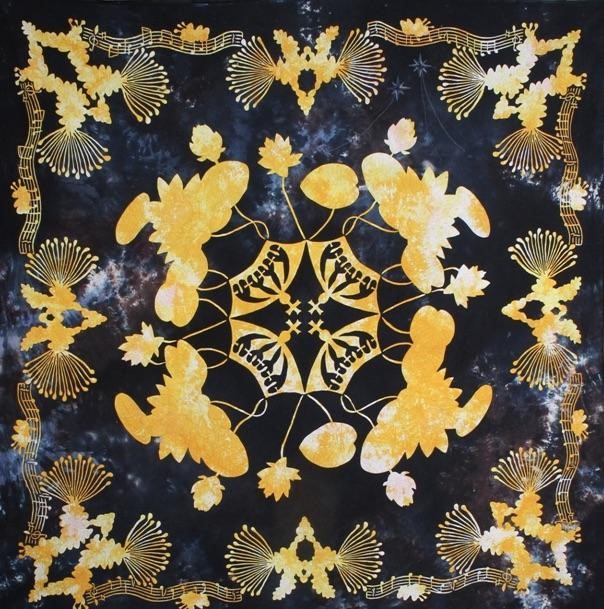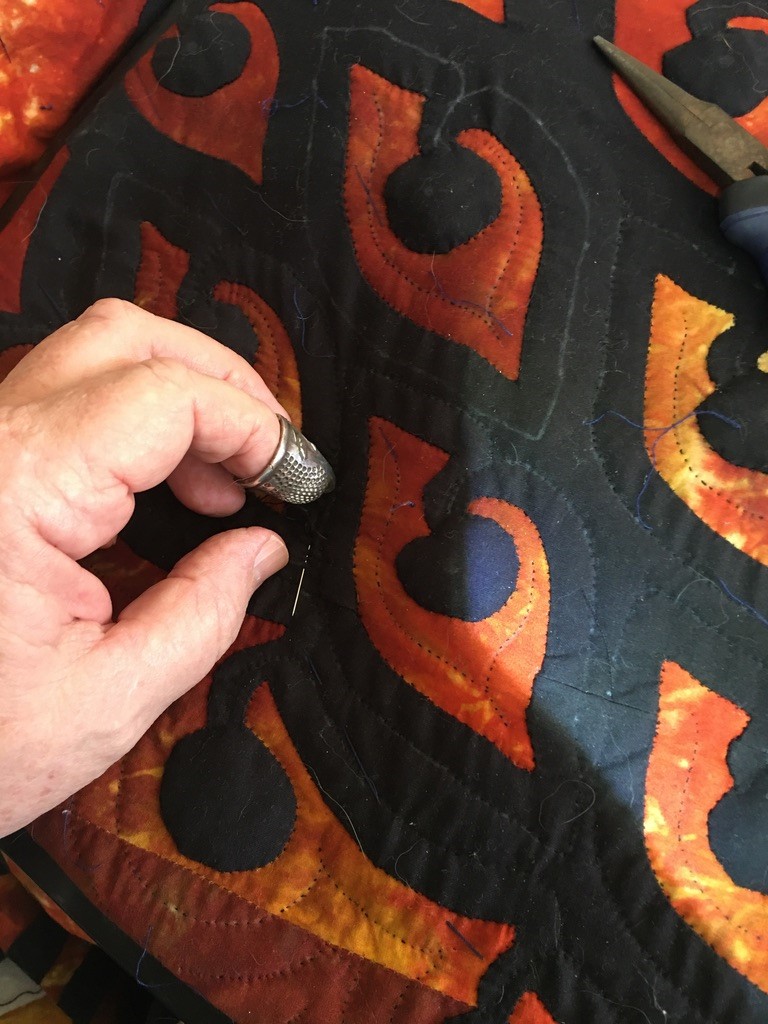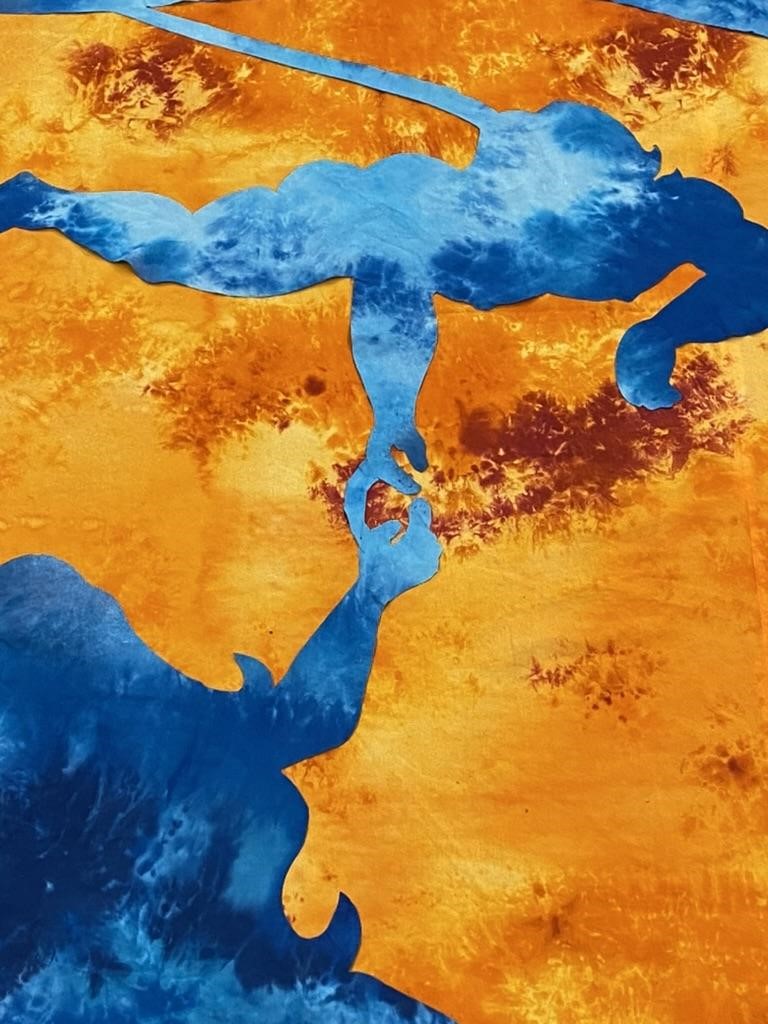About
Hawaiian Quilting

What makes it a Hawaiian quilt?
“Oh, my gosh! Have you ever seen anything so beautiful! Look at this magnificent piece of artwork!” The excited yet typical reply of a tourist upon first gazing upon a Hawaiian quilt, displayed on a wall of their hotel.
Yes, they are astounding to behold. The first time; the one hundredth time; every time–they have a Beauty unmatched in the quilting world. Not better, mind you, just distinctively and definitely unique in the universe of fabric art.
So what makes a Hawaiian quilt? Through more than two hundred years since American missionaries first taught Hawaiian women to sew western fabric with needle and thread, the art form of Hawaiian quilting has evolved to employ five key elements:
- Whole cloth applique. Unlike American applique, which typically uses numerous small swatches of varying pattern and color, a Hawaiian quilt applique is cut from one whole cloth.
- Hand, needle-turn applique. In a Hawaiian quilt, the sewer uses a needle to turn under the raw fabric edge and stitch it to the underlying background fabric. The entire quilt applique gets sewn by hand. A Hawaiian quilt actually gets sewn TWICE!
- The one-eighth, snowflake design of the applique fabric is perhaps the first element that leaps out to capture the amazed attention of the viewer. The Hawaiian quilt employs the same technique of cutting paper snowflakes that we all remember from when we were children.. The snowflake-design applique gives a Hawaiian quilt that mesmerizingly beautiful repeat of the identical pattern eight times around the quilt.
- Echo quilting is the one element that is unique in the world of Hawaiian quilting. Just recall throwing a stone into the water. Watch the ripples pulse outward from that initial splash. Now imagine two stones tossed near one another. See how the tiny waves meet and merge to create a new rippling effect. In a Hawaiian quilt, the applique itself determines the flow of the hand stitching. Following the curving edge of the flower or the design, the quilter stitches in rows that expand outward from the flower, soon intersecting with a neighboring element to create a unique rhythm to the stitching rows.
- The last element has been agreed and added by Hawaiian quilters in the last couple of decades. A Hawaiian quilt is entirely sewn by hand. In our age of commercialism and consumption, some enterprising enthusiasts have pounced upon the idea of a Hawaiian quilt. Using the whole-cloth, one-eighth motif, these folks have used a modern sewing machine to accomplish their quilts. Faster; cheaper; easy to market–and WRONG! The essence and the beauty of a Hawaiian quilt resides in the heart. The hours and months of steady, careful, hand stitching unveil the marvel of a piece of cloth that embodies “the Spirit of Aloha.”
Evolution of the Hawaiian quilt
American missionaries first arrived in Hawaiʻi in 1820 from Massachusetts. Missionary diaries document that soon after their arrival, the women began teaching Hawaiians “to employ the use of needle and thread.” Hawaiians had made kapa cloth by pounding, stretching, and joining pieces of bark from the mulberry tree (wauke). So labor-intensive and prized was kapa that it was rare, perhaps often used only for ceremonial rituals and for royalty.
With the arrival of western tools and fabric, Hawaiian women eagerly embraced this new and novel craft. The sewing of fabrics thrived among the Hawaiians. And here enters the origin of one of the unique elements of a Hawaiian quilt. Between the years of 1820-1900, western fabric was indeed scarce. It came only by ship from San Francisco. And early imported cotton fabrics were entirely of three colors: white, red, and navy blue. This explains how the whole-cloth applique evolved. Almost all of the earliest Hawaiian quilts (and many still today) use red or navy blue on a white background. Whole-cloth, two-color applique!
Every book that I have ever read on the origin of Hawaiian quilting tells the story of a Hawaiian woman gazing upon a sheet, lying on the ground with sunlight casting shadows of the leaves onto the cloth. The Hawaiian woman saw the form that became the Hawaiian applique flower. It makes a great story. It may indeed have some validity. Personally, I think the notion makes better storytelling than a history lesson.
It seems to me no mystery that the focus of a majority of Hawaiian quilt patterns employ Hawaiian plants and flowers. The magic of tradewind breezes wafting the scents of Hawaiian flowers is palpable everywhere.. Hawaiian people live among nature. Of course, we quilt our flowers!

Another bit of history sheds light upon the “unique” one-eighth designs in Hawaiian quilts. Around the year 1860, a subsequent influx of missionaries arrived in the Islands from Pennsylvania. At this time, women of Pennsylvania Dutch heritage were employing a quilting pattern called, scherenschnitte. This technique involved using a one-eighth, snowflake design applique on a background fabric. Translation–Hawaiian one-eighth applique technique!
What makes it a Hawaiian quilt?
What makes it a Hawaiian quilt?
Hawaiian Quilting
the Perfect Answer

I must comment on one aspect of Hawaiian quilting that impacts me so personally. Prior to western contact, Hawaiians made kapa from the bark of the mulberry tree. With the arrival of western fabrics and tools, Hawaiians quickly shifted and adopted the practices of sewing fabrics with needle and thread.
But the Hawaiian spirit did not suddenly turn American. The heart and soul of Hawaiian people so infused and evolved the craft of Hawaiian quilting. With little documentation in the years after the missionaries arrived in Hawaiʻi, we don’t know the details. What we do know is that by 1860’s, an entirely new, unique, and exquisite form of quilting had emerged.
When I sat down with Aunty Vi beside Hilo Bay on that summer afternoon in 1998, I knew that my heart and soul “had come home!” After a decade living in Hawaiʻi and wondering what and how I could contribute to Hawaiian culture, I found my answer. In Hawaiian quilting, we have the merging of the most beautiful elements of two cultures. How fitting for this haole man from Midwest America, who had adopted Hawaiʻi as his heart home! Hawaiian quilting feeds my soul.
One unique (to Americans) aspect of Hawaiian quilting is the manner of learning. While quilting is a western craft, in Hawaiʻi, quilting is taught in the old Hawaiian way. In old Hawaiʻi, knowledge and skills were passed from generation to generation, from grandmother to granddaughter. The younger one was invited to help tutu. By observing, by assisting with lesser tasks, by absorbing the experience, the youth learned the traditions and skills of their culture.
Hawaiian quilting, like all Hawaiian crafts, is taught and learned through hands-on experience. No book learning or classroom education. Hawaiians learn by watching, helping, and doing.
Today, as we strive to preserve the precious heritage of Hawaiian quilting, the words of local Hawaiian women are remarkably universal, “Oh, I was taught by my grandmother as a young girl. I had to help tutu. I didnʻt begin to quilt then. I was too busy with family and career. But when I had raised my children, then I remembered. I found that I knew how to cut and stitch my own kapa.”
the
Hawaiian
way

Hang Loose!
One final comment from Ric here… Today, Hawaiian quilting may be a diminishing art form. Busy lives; sewing machines; how-to classes; our consumption-based modern world. It is such a challenge for Hawaiian quilting to compete and remain vital. Yet, in this modern world of the rush to get it done, is it not all that much more important that we preserve those things that make us slow down, smell the flowers, and, yes, stitch the flowers, one hand stitch at a time!
I began this section by listing the five elements of a Hawaiian quilt. Indeed, I am at the head of the line in “breaking the rules!” In almost every quilt, I do something new and not traditional. I am inspired to create entirely new quilt patterns. I donʻt follow the rule of one-eighth design. I use realistic rather than echo quilting in my flowers/ elements. And I do these things deliberately and with purpose.
Many quilters today copy and reproduce the old quilt patterns. They are simple and beautiful. Some have been with us (always with subtle changes) for over one hundred years. In many of the old patterns, you cannot even identify and name what the flower is! Personally, I love and admire these old patterns. But they are OLD! To quilt these would bore me and leave me without the inspiration to birth something that Spirit leads me to create.
I believe that the element of creativity is vital in our endeavor to preserve Hawaiian quilting. The five elements are important. They hold the standard for what makes a Hawaiian quilt. But nothing in life–nothing in the Hawaiian way–is static and unchanging. Let us inspire ourselves and our keiki (children) to preserve and continue this old Hawaiian way, while continuing to breathe ka hā ola (the breath of life) into our majestic works of art!

